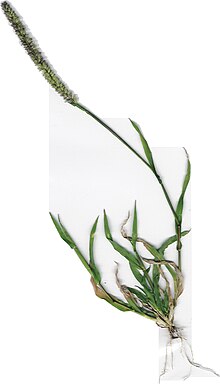Burdock grasses
| Burdock grasses | ||||||||||||
|---|---|---|---|---|---|---|---|---|---|---|---|---|

|
||||||||||||
| Systematics | ||||||||||||
|
||||||||||||
| Scientific name | ||||||||||||
| Tragus | ||||||||||||
| Haller |
The genus of the Velcro grasses ( tragus of ancient Greek τράγος (tragos) = goat) belongs to the family of grasses (Poaceae). The eight or so species are distributed almost worldwide. The genus is named after one of the fathers of botany , Hieronymus Bock (1498–1554), called tragus.
description

In tragus TYPES is annual or perennial herbaceous plants . The alternately arranged leaves are divided into leaf sheath and leaf blade. The leaf sheaths are open to the base. The ligule has the shape of a short lash line.
In the spike-shaped, racemose inflorescences , the spikelets stand in groups of two to five on short to seldom long stalks, which fall off as a whole when ripe. The spikelets are single-flowered, laterally compressed, the top one or two of each group are stunted and sterile. There are no awns . The flowers are hermaphroditic. The two glumes are very unequal, the lower one is small and delicate-skinned and transparent, the upper one is as long as the spikelet, ribbed, and has spiked hairs on the ribs that are either hook-shaped or straight, standing on knots. The lemma is three-ivyed, membranous, slightly shorter than the upper glume. The palea is double-veined, as long as the lemma, with broad, folded sides. There are three stamens . The two styluses end in feathery scars.
The caryopsis is ellipsoidal to oblong and slightly flattened at the top. The embryo takes up almost half the length of the caryopsis.
ecology
The groups of spikelets attach themselves to animal hair with the help of the hooked spines on the upper glumes and are thus spread out. Tragus species are therefore easily carried along with wool.
Systematics and distribution
The genus Tragus was first published in 1768 by Albrecht von Haller in Historia Stirpium Indigenarum Helvetiae Inchoata , 2, p. 203. Type species is Tragus racemosus (L.) All. Synonyms for Tragus All. are: Lappago Schreb. nom. superfl., Nazia Adans. nom. rej ., Echisachys Neck. , Echinanthus Cerv. Tragus All. nom. cons. were preserved according to the rules of the ICBN (Vienna ICBN Art. 14.4 & App. III) against Nazia Adans. nom. rej. ( Nazia published in Michel Adanson : Familles des Plantes , 2, 1763 31, 582).
The genus Tragus belongs to the tribe Cynodonteae in the subfamily Chloridoideae within the family Poaceae .
The distribution area of the genus tragus is almost worldwide. With six species, the main distribution area is in Africa . There is only one species in Europe.
About eight species belong to the genus tragus :
- Tragus andicola M.A. Zapater & Sulekic : It is native to northwest Argentina.
- Tragus australianus S.T.Blake : It occurs in Australia , New Caledonia and as a neophyte in western and southern South America.
- Tragus berteronianus Schult. , Syn .: Lappago berteroniana (Schult.) Schult. ex Steud. , Tragus racemosus var. Berteronianus (Schult.) Hack. , Tragus occidentalis Nees , Lappago racemosa var. Erecta Kunth nom. nud., Tragus ciliatus Lepr. ex Kunth , Lappago phleoides Fig. & De Not. , Tragus racemosus var. Brevispiculus Döll , Tragus tcheliensis Debeaux , Nazia occidentalis (Nees) Scribn. , Lappago occidentalis (Nees) Hook.f. , Tragus alienus var. Brevispinus Henrard : It is distributed from Africa via the Arabian Peninsula to China. It is an invasive plant in many areas of the world.
- Tragus heptaneuron Clayton : It occurs in Somali, Kenya and Tanzania and as a neophyte in Australia.
- Tragus koelerioides ash. , Syn .: Tragus racemosus var. Major Hack. , Tragus major (Hack.) Stapf : It occurs in Zimbabwe as far as southern Africa .
- Tragus mongolorum Ohwi , Syn .: Tragus roxburghii Panigrahi : It occurs from north-eastern Ethiopia, on islands in the western Indian Ocean and from tropical Asia to Mongolia .
- Tragus pedunculatus Pilg. : It occurs only in Botswana and Namibia . It is also called Orthacanthus pedunculatus (Pilg.) PMPeterson & Romasch by some authors . placed in the genus Orthacanthus .
- Grape burdock ( Tragus racemosus (L.) All. , Syn .: Cenchrus racemosus L. , Phalaris muricata Forssk. Nom. Superfl., Cenchrus linearis Lam. Nom. Superfl., Lappago racemosa (L.) Honck. , Lappago biflora Roxb . nom. superfl., Tragus racemosus var. longispicula Döll nom. inval., Nazia racemosa (L.) Kuntze ): The wide distribution area extends from Europe to Central Asia and from tropical to southern Africa and to Pakistan .
literature
- T. Cope: Tragus Haller in Flora Zambesiaca , Volume 10 - Gramineae , 1999: Volltext-online. (Section description)
- Oskar Sebald, Siegmund Seybold, Georg Philippi: The fern and flowering plants of Baden-Württemberg , Ulmer Verlag, Volume 7
Individual evidence
- ↑ Lotte Burkhardt: Directory of eponymous plant names - Extended Edition. Part I and II. Botanic Garden and Botanical Museum Berlin , Freie Universität Berlin , Berlin 2018, ISBN 978-3-946292-26-5 doi: 10.3372 / epolist2018 .
- ↑ a b c d T. Cope: Tragus Haller in Flora Zambesiaca , Volume 10 - Gramineae , 1999: Volltext-online.
- ^ A b c Tragus in the Germplasm Resources Information Network (GRIN), USDA , ARS , National Genetic Resources Program. National Germplasm Resources Laboratory, Beltsville, Maryland. Retrieved April 22, 2013.
- ↑ a b c d e f g h i j Rafaël Govaerts (Ed.): Tragus. In: World Checklist of Selected Plant Families (WCSP) - The Board of Trustees of the Royal Botanic Gardens, Kew . Accessed January 31, 2020.
- ^ Tragus at Tropicos.org. Missouri Botanical Garden, St. Louis, accessed April 22, 2013.
- ↑ Eckehart J. Jäger (Ed.): Rothmaler Exkursionsflora von Deutschland , Gefäßpflanze Grundband, 20th edition, Spectrum, 2011, p. 303
